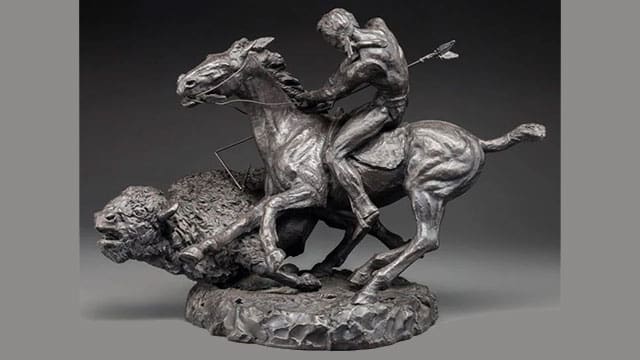How cultural Marxists are decolonizing the art collection and rewriting history at the University of Manitoba
 “Who controls the past controls the future. Who controls the present controls the past,” wrote George Orwell in 1984. This concept is evident today as Cultural Marxists decolonize the University of Manitoba’s art collection.
“Who controls the past controls the future. Who controls the present controls the past,” wrote George Orwell in 1984. This concept is evident today as Cultural Marxists decolonize the University of Manitoba’s art collection.
In a recent CBC article, reporter Karen Pauls examined the removal of “white-centric” art from the University of Manitoba. C.W. Brooks-Ip, the registrar and preparator of the university’s art collection, argued that the issue wasn’t just the problematic art but the institution itself, which he described as fundamentally colonial.
“The university is ultimately a colonial institution that is designed to serve white people … and that needs to change,” said Brooks-Ip.
“We have had artwork that is by a white settler that depicts Indigenous folks in not really an accurate way, in sort of the mythologized way, that in some ways glorifies the white settlers – or at least reinforces their white supremacy.”
 A buffalo hunt sculpture by Thomas Holland was removed as being too “white-centric” |
| Related Stories |
| The modern left is at war with history
|
| Elizabeth II had the poise to navigate the cesspool of colonialism
|
| Wokeism is leading to the fall of fact-based medicine
|
Brooks-Ip, who appears to be white, seems mistaken about the university. Many Indigenous people receive special access to post-secondary tuition funding, and numerous international students attend, making it hard to label any Canadian university as colonial.
Brooks-Ip commented on a painting by Lionel Stephenson, who lived in Winnipeg between 1885 and 1892, that was removed from the university president’s office. The painting depicts an Indigenous person sitting outside their teepee, looking at a canoeist on the river with Upper Fort Garry in the background.
To Brooks-Ip, this clearly showed “the threat of direct colonization.”
“It’s kind of depicting a ‘We’re over here and they’re over there’ type situation,” Brooks-Ip said. “It’s not showing community and togetherness. It’s showing the separation between the river and the settlement.”
One wonders what depiction would satisfy modern leftist views. If people were shown living harmoniously, would it be criticized for assimilation or whitewashing history? Critical theory seems to exist only to criticize.
To decolonize the university’s art, Brooks-Ip initiated a two-year pilot project funded with $30,000 from the Office of the Vice-President (Indigenous). The Indigenous Student-Led Indigenous Art Purchase Program allows students to select art pieces for display across the campus.
Jory Thomas, a third-year architecture student and Red River Metis who co-coordinates the project committee, appears ready to distance herself from the white side of her heritage. Nonetheless, she aims to accurately depict Indigenous history.
One removed artwork is a buffalo hunt sculpture by Thomas Holland, which has been criticized for not representing Indigenous perspectives of cultural understanding, respect, and gratitude for the animal’s sacrifice.
“While the depiction may be historically accurate, it wasn’t created from an Indigenous perspective of cultural understanding, respect, and gratitude for the animal’s sacrifice,” said Thomas, whose clan animal is the buffalo. “Images like this perpetuate harmful stereotypes of angry, violent Indigenous people, fostering a hostile environment on campus,” she said.
Thomas suggested depicting the preparation of a hunted buffalo instead of the hunt itself to avoid perpetuating harmful stereotypes of violence. This perspective suggests that both art and history are being selectively chosen and displayed, highlighting certain aspects while ignoring or excluding others.
Historical art is being replaced by newer works, such as a 2024 soapstone carving by Frederick Lyle Spence, an Ojibway artist. Spence believes his work should stay with him until it absorbs enough positive energy before moving to a new home.
Riva Symko, head of collections and exhibitions at Winnipeg Art Gallery-Qaumajuq, supports these efforts and advocates hiding some colonial art to protect Indigenous people from trauma.
“We do need to put things away to make space for other voices to be heard and seen. Sometimes we need to put things away because they’re traumatic, because they are harmful … especially to our Indigenous visitors and audiences,” she said.
“The future will tell whether we burn them down, or whether we store them away and lock them in the vault, or whether we bring them out and use them for discussion.”
So here we are. Taxpayer-funded institutions are destroying one group’s culture and history to assert a contemporary version of their own. Art collectors are speculating about destroying all art they disagree with. People at institutions of higher learning can’t perceive their shortcomings and believe they are doing the right thing.
This raises the question of what Canada will become if its culture and history are dismantled.
Lee Harding is a Research Fellow at the Frontier Centre for Public Policy.
For interview requests, click here.
The opinions expressed by our columnists and contributors are theirs alone and do not inherently or expressly reflect the views of our publication.
© Troy Media
Troy Media is an editorial content provider to media outlets and its own hosted community news outlets across Canada.
